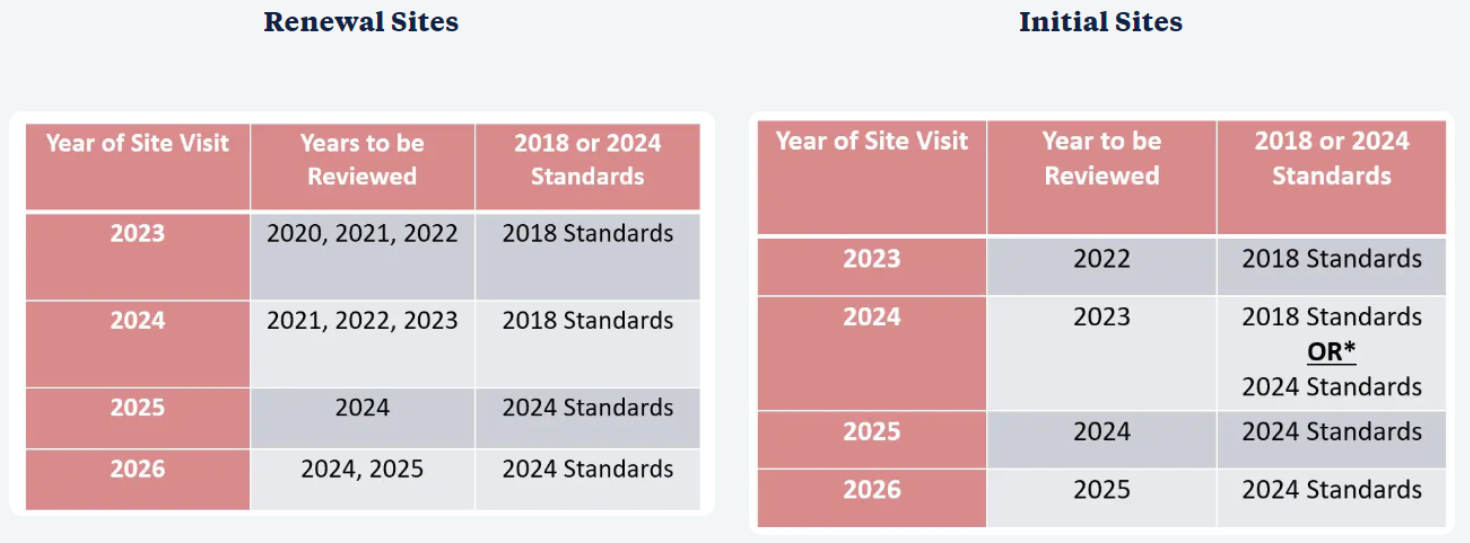The new year feels far away, but for breast centers accredited by the American College of Surgeons “National Accreditation Program for Breast Centers (NAPBC)”, January 1, 2024, is top of mind.
The new NAPBC Standards Manual (2024) is a shift to more personalized care delivery with greater use of risk assessment and preventative protocols. To maintain accreditation, centers will need to offer a new standard of care that includes:
Performing cancer risk evaluation at the time of breast screening or diagnosis; care protocols for patients at increased risk due to dense breast tissue, lesions, lifestyle or family history
Considering genetic testing for all newly diagnosed patients with breast disease or breast cancer and patients determined to be at high risk for genetic predisposition to breast cancer
Informing and educating patients with increased breast density and breast cancer risk
Ensuring breast density, cancer risk status, and consideration of genetic testing is documented in the patient record
When NAPBC surveyors visit sites in 2025, they will be looking for compliance with the new standards in patient records from 2024. Breast centers should be working now to create plans aligning the people, process, and technology for this new “for patients” approach.

https://www.facs.org/quality-programs/cancer-programs/national-accreditation-program-for-breast-centers/standards-and-resources/ accessed 27th September 2023
Dr. Sarantou, Surgical Oncologist, a contributor to the guidelines and an NAPBC site surveyor, recently presented his perspective on the guidelines and initial learnings from the pilot centers in World ClassCME’s “A Guide to NABPC standards” webinar, sponsored by Volpara.
Dr. Sarantou highlighted that some sites are choosing to use calculators and templates to scale and cover all patients without a big impact to workflow. He also observed many genetic professionals are being asked to weigh in on risk screening strategies, which may create a larger focus on hereditary risk.
Volpara Risk Pathways® offers an integrated technology solution that can address the four capabilities – risk assessment, genetic testing consideration, density inform and medical record documentation—all within a single tool and workflow.
Centers considering their 2024 NAPBC standard strategies can learn from the experience of these leading Volpara customers:
Assess risk of every mammography patient: Rush University Medical Center is one of the first academic medical centers in Illinois to make breast and ovarian cancer risk assessment a foundational component in their screening program. Rush screens approximately 24,000 patients annually and utilizes the seamless integration Volpara Risk Pathways offers with their electronic health record (EHR) system, Epic®. Volpara Risk Pathways delivers risk results automatically and updates the Epic patient record. This approach means staff could eliminate double entry, and the manual and time intensive work that they might have to take on if they used a standalone risk tool. For every screening and diagnostic mammogram, breast cancer risk is assessed with the Tyrer-Cuzick v8 Risk Evaluation Tool (TC8), Gail 5-Year, and the NCCN Clinical Practice Guidelines in Oncology (NCCN Guidelines) – giving clinical staff a comprehensive understanding of risk for every patient and evidence to direct their care protocol.
Consider genetic testing: Singing River Health System started their cancer risk assessment program in 2020 with the goal of identifying patients at high risk for breast cancer and those with hereditary genetic mutations. Singing River selected Volpara Risk Pathways software to power their risk assessment workflow, including assessing eligibility for genetic testing. In two years, 25% of screening patients met the NCCN guidelines for genetic testing and approximately 36% complied, completing the genetic test onsite at Singing River. Results demonstrated that 114 patients (6%) had either pathogenic mutations (73) or carrier status (41). Eight hundred and thirteen patients (42%) received negative genetic results but were found to still be at elevated cancer risk—based on personal or family history—and were directed to new surveillance recommendations.
Inform patients about breast density: Southtowns Radiology is a medical imaging center providing mammography services in Buffalo, NY and is renowned for its same-day results and compassionate breast care. This includes informing patients about their mammogram results, breast density category, and any recommendations for further screening – while they are still at the center. Southtowns’ 85% compliance rate for supplemental screening recommendations for their dense breast patients is outstanding. To maintain their position at the forefront of dense breast screening programs, Southtowns knew they wanted to go beyond simply informing patients by building greater understanding and inspiring more patient action. Recently, the center made an impressive move to increase breast density education by adding Volpara Thumbnail™ to their mammography results letter. This new letter template includes two non-diagnostic clinical images from the patient exam and explains what breast density means in simple-to-understand terms with visuals and resources. The additional information on breast density with images in the result letters has been successful and has not caused an increase in patients calling the center expressing concerns.
Patient Medical Record at the source of truth: When Kettering Health set out to launch its cancer prevention program, they recognized information technology’s central role in streamlining cancer risk assessment, care coordination, and patient management on a grand scale. They selected Risk Pathways and its deep integration with their Epic EHR system to enable providers across multiple disciplines to assess cancer risk in any patient encounter. Having discrete cancer risk scores integrated into their EHR, Kettering Health can measure the performance and impact of their cancer prevention program. This includes tracking the number of patients evaluated for cancer risk, the percentage of high-risk patients, usage of preventive measures such as breast MRI recommendations, and much more.
Looking for guidance or assistance? Schedule a demo or an appointment to explore Volpara’s tools and professional services.

